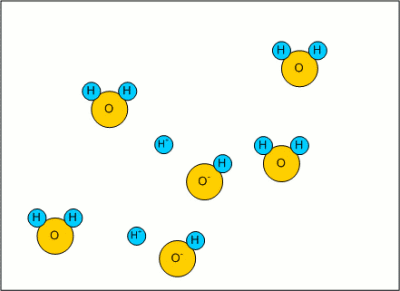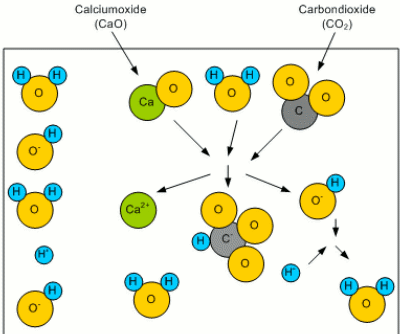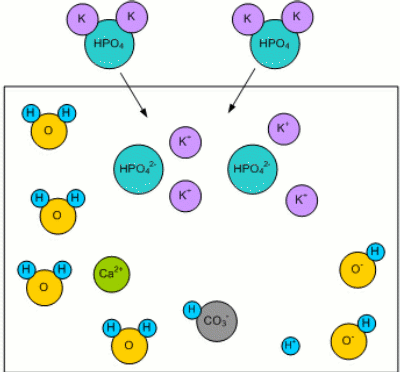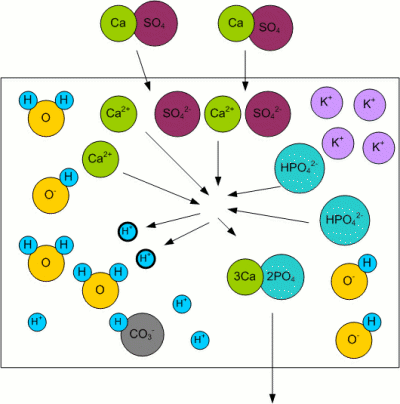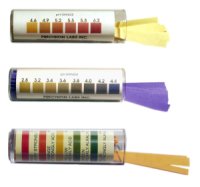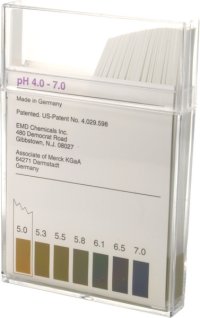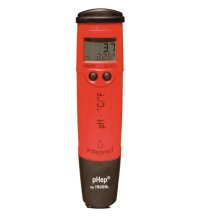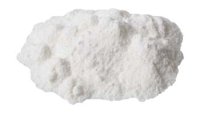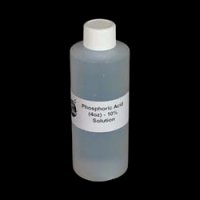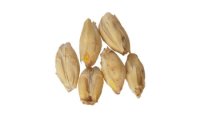Difference between revisions of "Residual Alkalinity illustrated"
(→Residual Alkalinity) |
(→Residual Alkalinity) |
||
| Line 52: | Line 52: | ||
RA = KH - (CH + 0.5 * MH)/3.5 | RA = KH - (CH + 0.5 * MH)/3.5 | ||
| − | Where RA is the residual alkalinity in dH, KH the alkalinity (carbonate hardness), CH the Calcium Hardness and MH the Magnesium Hardness. But a water report usually doesn't show these parameters as dH, especially outside of Germany. In order to convert this formula such that it can be used with ppm as the unit, the molar weight of the carbonate, calcium and magnesium ions has to be taken into account. Though this is straight forward, it involves juggling a lot of numbers and since it doesn't help in understanding water chemistry i created a spread sheet for making these calculations: [http://braukaiser.com/documents/ | + | Where RA is the residual alkalinity in dH, KH the alkalinity (carbonate hardness), CH the Calcium Hardness and MH the Magnesium Hardness. But a water report usually doesn't show these parameters as dH, especially outside of Germany. In order to convert this formula such that it can be used with ppm as the unit, the molar weight of the carbonate, calcium and magnesium ions has to be taken into account. Though this is straight forward, it involves juggling a lot of numbers and since it doesn't help in understanding water chemistry i created a spread sheet for making these calculations: [http://braukaiser.com/documents/Kaiser_water_calculator.xls Kaiser_water_calculator.xls] |
==Malt and Beer Color== | ==Malt and Beer Color== | ||
Revision as of 04:27, 7 December 2009
|
Contents[hide]Water and pHLet's start with distilled water. Pure water contains only H2O molecules. Some of these molecules disassociate into a proton (H+) and a hydroxide (OH-) ion. pH (see Wikipedia pH) is a logarithmic measure of the proton ion concentration in a solution. A pH of 7 indicates neutrality (i.e. the pH of pure water) because water naturally dissociates into H+ and OH− ions with equal concentrations of 1×10−7 mol/L [Wikipedia]. The illustration on the right shows distilled water where 2 of the water molecules disassociated into 2H+ and 2OH-: H20 <-> H+ + OH-
AlkalinityWhen this water rains down from the atmosphere, it picks up CO2 to form carbonoic acid. Even more CO2 is picked up while the water trickles through the soil. This carbonic acid is then able to react with minerals like calcium to form calcium oxide: CaO + H2O + CO2O -> Ca2+ + HCO3- + HO- The result of this reaction are a bicarbonate (HCO3-) and a hydroxide (HO-) ion. Both of which can bind a proton (H+) and thus reduce the number of free protons. This results in an increased pH (less acidic) as well as in an increased buffering capacity. The latter is the ability of the solution to resist a change of pH (concentration of protons) even if additional protons are added (e.g. through the addition of an acid). The bicarbonate ion (HCO3-) reacts with the added protons (H+): HCO3- + H+ -> H2O + CO2O Forming water (H2O) and carbon dioxide (CO2O). This buffering capacity is called the alkalinity of the water and can be expressed as either ppm HCO3 or ppm CaCO3. The latter is an equivalent concentration of dissolved chalk (CaCO3) that hat provides the same alkalinity.
Adding MaltWhen malt is added, the malt's phosphates (mainly potassium phosphate K2HPO4 [Fix,1999]) dissolve in the mash water: K2HPO44 -> 2K+ + HPO42-
Residual AlkalinityKolbach, a German brewing scientist, found that the malt's phosphates react with the calcium and magnesium ions from the mash water [Fix, 1999]: 3Ca2+ + 2HPO42- <-> 2H+ + Ca3(PO4)2 This reaction releases 2 protons (H+) as well as calcium phosphate (Ca3(PO4)2) which is pretty much insoluble in wort and precipitates. The important aspect however is the release of 2 protons which can react with the bicarbonate ions (HCO3-) that are responsible for the water's alkalinity [Narziss, 2005]: H+ + HCO3- -> H2O + CO2 The result is a lowered alkalinity or buffering capacity of the water. If no more bicarbonate ions are present, the pH sinks due to the increase of protons (H+). Kolbach's work found that not all of the water's calcium and magnesium ions take part in the aforementioned reaction. He found that only 2 out of 7 calcium ions and one out of 7 magnesium ions react with the malt's phosphates to release protons. This resulted in the definition of residual alkalinity, which is a measure of the alkalinity left after the acidifying reaction between the malt's phosphates and the water's calcium and magnesium has been taken into account: When the calcium, magnesium and bicarbonate concentrations can be expressed in an unit that is equivalent to the ion concentration (as opposed to the weight concentration) of these ions (like dH (German Hardness) or mEq/l), the equation for the residual alkalinity simply is: RA = KH - (CH + 0.5 * MH)/3.5 Where RA is the residual alkalinity in dH, KH the alkalinity (carbonate hardness), CH the Calcium Hardness and MH the Magnesium Hardness. But a water report usually doesn't show these parameters as dH, especially outside of Germany. In order to convert this formula such that it can be used with ppm as the unit, the molar weight of the carbonate, calcium and magnesium ions has to be taken into account. Though this is straight forward, it involves juggling a lot of numbers and since it doesn't help in understanding water chemistry i created a spread sheet for making these calculations: Kaiser_water_calculator.xls Malt and Beer ColorResidual Alkalinity is only one factor in the final mash pH. Another important factor is the color of the malts that are used. Darker malts (base malts as well as specialty malts) contribute additional acidity other than the one described above. This acidity also counteracts the alkalinity of the water and needs to be taken into account to ensure that the resulting mash pH is in the preferred range of 5.3 - 5.6. This has been taken into account in Palmer's Normograph, where he gives a color scale on which the residual alkalinity target can be matched with the anticipated beer color. Temperature dependency of the pH measurementThe pH of a solution changes with its temperature. This needs to be taken into account when measuring the pH and determining what the pH target is. Some authors cite the pH ranges and targets at the actual reaction temperature (i.e. rest temperature) and others cite the pH values as if measured in a cooled sample. The latter makes sense since it is a good practice to cool a sample before measuring it with a pH meter. It also gives a common reference and allows for giving pH values without the need of giving a temperature as well. Unless otherwise noted, all pH values on this wiki are pH values measured at room temperature (25 C). To make matters even worse, the temperature dependency of the pH is also dependent on the substrate itself. Briggs quotes a difference of 0.35 in pH between a mash pH measured at mash temps and the same liquid measured at room temp. The pH measured at mash temp is lower [Briggs, 2004]. Measuring Mash pHThough it is oftentimes good enough to target a particular residual alkalinity for a particular style of beer, only a measurement of the mash pH can tell how well this target has been achieved. The home brewer has 3 common options to choose from: Litmus paperLitmus paper contains a dye that changes color when exposed to an acid or base. The extent of the color change is matched against a scale to determine the pH of the sample. Litmus paper, generally known as pH test strips, are a cheap way of determining the mash pH. But because they operate over a fairly large pH range and the dye tends to run into the sample they are hard to read. But they are sufficient to check if the mash pH is somewhat close to the anticipated target. Pro
Con
precision test stripsEMD Chemicals makes pH test strips (colorpHast) that also use a pH sensitive dye, but this dye will not run like litmus paper. It also shows a stronger change of color over a narrow pH range which makes them easier to read and more precise than litmus paper. But a comparison against a pH meter has shown that these strips can show a systematic error that was also confirmed by EMD Chemicals: colorpHastStrips vs. a pH meter Note that these strips also need to be read in natural or tungsten light. Fluorescent light will make the reading appear in a different color. This can be a problem if you tend to brew late at night and have energy saving light bulbs. Pro
Con
pH meterA pH meter (Wikipedia: pH meter) converts the pH difference between the sample liquid and a reference liquid, which is inside a bulb at the tip of its probe, into a voltage difference that can be measured and converted into a pH reading. These instruments are able to measure pH very precisely. But this precision comes at a price: not only are pH meters relatively expensive, their electrodes have only a limited lifetime of 1-2 years when cared for well. They also require constant maintenance like calibration and the tip of the electrode needs to be stored wet. Pro
Con
Use
What to get?The ColorpHast pH measuring strips are the best value for their price. They can be cut into smaller strips to make them last and are sufficiently precise and easy to read for all grain brewing. But keep in mind that they can be off by a few 10th pH units and when you experience mash and sparge pH related off flavors, you may want to adjust the value read by a few 10th pH units. A pH meter is recommended if you have other than mashing uses for it. Because of its precision it can also be used to monitor the pH of the fermentation and finished beer. A rise in the beer pH for example can be an indication of autolysis due to the release of the more basic/alkaline contents of yeast cells into the beer. Means of adjusting the mash pHWhen the mash pH has been measured and determined to be out of range, there are several methods available to fix this problem: Lowering Mash pHCalcium and Magnesium additionsAccording to the equation above, calcium and magnesium will reduce the mash pH if they are added as non carbonate/bicarbonate salts (Chalk CaCO3 does not lower the pH because it increases the alkalinity of the water more than it's calcium part is able to lower it). But since not all of the calcium and magnesium ions react with the malt's phosphates, the amount that can be added to counteract the alkalinity of the water is limited by the calcium and magnesium levels appropriate for a particular style of beer. Another factor to be considered is, that Ca and Mg need to be added as salts which will also contribute sulfates (calcium sulfate (Gypsum, CaSO4) and magnesium sulfate (Epsom salt, MgSO4)) and/or chlorides (calcium chloride (CaCl)). Excessively high sulfate and chloride concentrations may also lead to undesirable beer flavors. Palmer suggests the following ranges for Ca, Mg, SO4 and Cl in brewing water [Palmer, 2005]:
The effect of the Sulfates on hop bitterness are one reason why many brewers prefer calcium chloride (CaCl2) additions over gypsum (calcium sulfate, CaSO4) additions for mash acidification.
Foodgrade Acid AdditionsAcid additions work by contributing H+ ions to the mash. These ions react with the bicarbonate ions to lower the alkalinity or simply increase the H+ concentration to lower the pH of the mash. Pretty much any food grade acid, from phosphoric acid to vinegar (acedic acid), can be used in the mash. But brewers commonly only use phosphoric acid, sufuric acid or lactic acid. These acids provide flavors that are most compatible with beer. Like salts, acids will also contribute ions other than the needed protons (H+) to the mash:
Sour Mash and WortBecause of the Reinheitsgebot (German purity law for beer) German brewers are not allowed to use acid or salts in their mash. But when they tried to brew the now popular light colored lagers with alkaline water they failed until they added soured mash to the mash. The sour mash is a mash that has been partially fermented by lactic acid bacteria which are available in abundance on the malt and are therefore not a violation of the RHG. In order to do a sour mash, the brewer mashes some grains to convert the starch into sugars. Then the mash is cooled to 80 *F (35*C) and some crushed malt is added to innoculate the mash with fresh lactic bacteria. This mash then sits overnight and starts fermenting. The next day it can be added to the regular mash and its lactic acid will serve to balance the alkalinity and lower the pH. The big problem with sour mashing is it's labor intensity and inconsistency. Because the bacteria on the malt is not a pure culture of lacto bacillus other flavor compounds can be created in the sour mash which may carry over into the finished beer. Wort can also be soured to be used for mash acidification as well as acidification during the boil.
Acid MaltFrom Narziss [Narziss, 2005]:
Acid malt has the same affect as adding lactic acid to the mash. It is generally easier to handle because it can easily be added by weight. The following chart shows 7 different mash thicknesses and how many % acid malt needed in the grist for a desired pH shift. 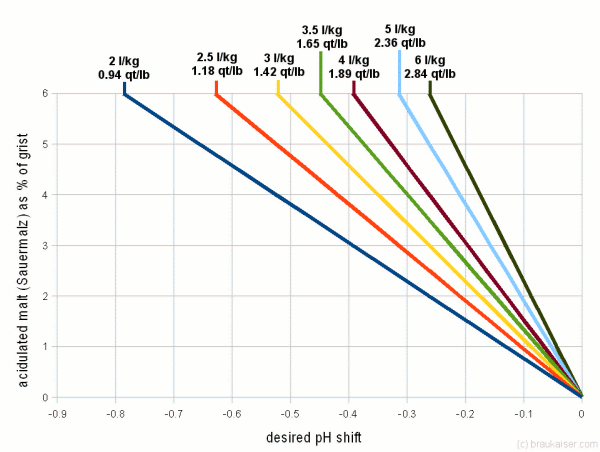 The gist percentage of acid malt that is needed for mash thicknesses ranging from 2 to 6 l/kg. This chart assumes a lactic acid content of 2.8 % by weight on the acid malt and a pH shift of 0.03 for every alkalinity drop of 1 dH (degree German Hardness). For simplicity you may neglect that the acid malt becomes part of the grist and simply multiply the existing grist weight with the acid malt percentage to get the required amount of acid malt. E.g. the grist weight is 4 kg, the mash thickness is 4 l/kg and the pH needs to be dropped by 0.2: 3% acid malt need to be added which is about 4 kg * 0.03 = 120 g
Acid restAn acid rest is a low temperature mash rest during which the malt's enzymes dismantle phytin to phytic acid [Noonan, 1996]. This reaction is different to the mash acidification that stems from the reaction of the malt's phospates with the calcium and magnesium ions. The optimal temperature for the acid rest is 95 *F (35 *C) and is most effective in undermodified pale malts. It is also the first rest in the classical tripple decoction mash. But since modern malts don't require such intensive mash schedules anymore the acid rest is rarely used anymore. Increasing Mash pHWhen brewing dark beers with fairly soft water, the acidity of the dark malts can result in a mash pH that is too low for proper enzymatic activity and eventually proper beer pH. In these cases it is necessary to increase the mash pH. This mash pH increase can be accomplished by the addition of bicarbonate salts like sodium bicarbonate (baking soda, NaHCO3) or calcium carbonate (chalk, CaCO3). These salts increase the alkalinity of the water which consumes H+ ions and increases the mash pH. Large amounts of sodium are undesirable in brewing water which is why chalk is preferred over baking soda. Five Star's 5.2 bufferFive Star Chemical Company (www.fivestarchemicals.com) makes a pH buffer called 52 from food grade phosphate buffers that can be added to the mash and will lock the mash pH at 5.2. It works by providing a buffer that is stronger than the buffering capacity of the mash and thus overrides it's pH. It is a very simple solution that works for most brewing waters and can give the brewer a consistent mash pH without even the need for mash pH measurements It's effectiveness is limited when used with very alkaline water because its buffer capacity, when used at the recommended dosage of 2oz / 31 gal, is not sufficient to overcome the water's strong alkaline buffer. At this point more 52 needs to be added which can result in off flavors due to the increased mineral content of the water. Conversely, when brewing with softer waters, less than the recommended dosage of 52 can be used to reduce the mineral additions to the water.
When to treat the mash pH ?The mash pH should be measured shortly after dough-in. If a pH correction needs to be made to the mash it should be done immediately because mash pH also effects the enzymatic activity. When adding salts or acids to the mash, they should be added in small dosages and the mash pH needs to be measured after each dosage has been added and well mixed with the rest of the mash. The latter is a very important step that can be difficult if the mash has a thick consistency. All necessary mash treatments should be recorded so that they can be done as water treatments (or in the case of acid malt as additions top the grist) before dough-in when the beer is brewed a second time. In this case no mash pH adjustment should be necessary after dough-in. Using the water chemistry spread sheet (water_calculator.xls) and a water analysis of the brewing water, potentially necessary water and mash treatments can already be planned before the beer is brewed the first time which avoids surprises after dough-in. Sources
|
